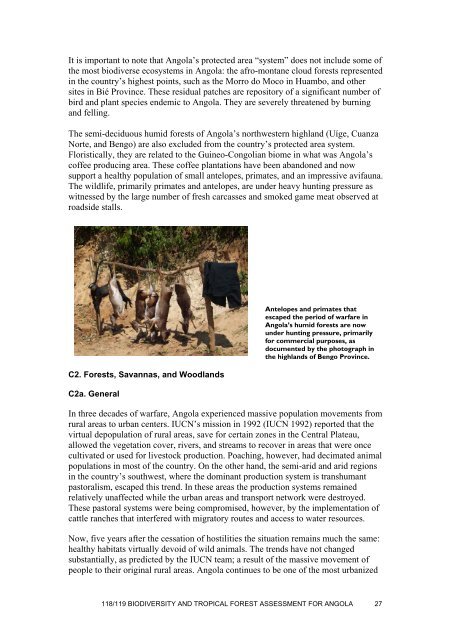118/119 Biodiversity and Tropical Forest Assessment for Angola
118/119 Biodiversity and Tropical Forest Assessment for Angola
118/119 Biodiversity and Tropical Forest Assessment for Angola
- No tags were found...
You also want an ePaper? Increase the reach of your titles
YUMPU automatically turns print PDFs into web optimized ePapers that Google loves.
It is important to note that <strong>Angola</strong>’s protected area “system” does not include some ofthe most biodiverse ecosystems in <strong>Angola</strong>: the afro-montane cloud <strong>for</strong>ests representedin the country’s highest points, such as the Morro do Moco in Huambo, <strong>and</strong> othersites in Bié Province. These residual patches are repository of a significant number ofbird <strong>and</strong> plant species endemic to <strong>Angola</strong>. They are severely threatened by burning<strong>and</strong> felling.The semi-deciduous humid <strong>for</strong>ests of <strong>Angola</strong>’s northwestern highl<strong>and</strong> (Uíge, CuanzaNorte, <strong>and</strong> Bengo) are also excluded from the country’s protected area system.Floristically, they are related to the Guineo-Congolian biome in what was <strong>Angola</strong>’scoffee producing area. These coffee plantations have been ab<strong>and</strong>oned <strong>and</strong> nowsupport a healthy population of small antelopes, primates, <strong>and</strong> an impressive avifauna.The wildlife, primarily primates <strong>and</strong> antelopes, are under heavy hunting pressure aswitnessed by the large number of fresh carcasses <strong>and</strong> smoked game meat observed atroadside stalls.C2. <strong>Forest</strong>s, Savannas, <strong>and</strong> Woodl<strong>and</strong>sC2a. GeneralAntelopes <strong>and</strong> primates thatescaped the period of warfare in<strong>Angola</strong>’s humid <strong>for</strong>ests are nowunder hunting pressure, primarily<strong>for</strong> commercial purposes, asdocumented by the photograph inthe highl<strong>and</strong>s of Bengo Province.In three decades of warfare, <strong>Angola</strong> experienced massive population movements fromrural areas to urban centers. IUCN’s mission in 1992 (IUCN 1992) reported that thevirtual depopulation of rural areas, save <strong>for</strong> certain zones in the Central Plateau,allowed the vegetation cover, rivers, <strong>and</strong> streams to recover in areas that were oncecultivated or used <strong>for</strong> livestock production. Poaching, however, had decimated animalpopulations in most of the country. On the other h<strong>and</strong>, the semi-arid <strong>and</strong> arid regionsin the country’s southwest, where the dominant production system is transhumantpastoralism, escaped this trend. In these areas the production systems remainedrelatively unaffected while the urban areas <strong>and</strong> transport network were destroyed.These pastoral systems were being compromised, however, by the implementation ofcattle ranches that interfered with migratory routes <strong>and</strong> access to water resources.Now, five years after the cessation of hostilities the situation remains much the same:healthy habitats virtually devoid of wild animals. The trends have not changedsubstantially, as predicted by the IUCN team; a result of the massive movement ofpeople to their original rural areas. <strong>Angola</strong> continues to be one of the most urbanized<strong>118</strong>/<strong>119</strong> BIODIVERSITY AND TROPICAL FOREST ASSESSMENT FOR ANGOLA 27
















